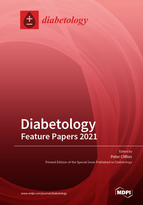Diabetology: Feature Papers 2021
A special issue of Diabetology (ISSN 2673-4540).
Deadline for manuscript submissions: closed (31 December 2021) | Viewed by 37794
Special Issue Editor
2. Alliance for Research in Exercise, Nutrition and Activity (ARENA), Adelaide, SA, Australia
Interests: obesity; lipids; diabetes; heart disease
Special Issues, Collections and Topics in MDPI journals
Special Issue Information
Dear Colleagues,
As Editor-in-Chief of the journal Diabetology, I am pleased to announce the Special Issue “Diabetology: Feature Papers 2021” is now online. Diabetology (ISSN 2673-4540) is an international, peer-reviewed scientific open access journal that provides an advanced forum for studies related to epidemiology, etiology, pathophysiology, pathogenesis, management, complications, and prevention of diabetes, including the molecular, biochemical, and physiological aspects of diabetes. In this Special Issue, “Feature Papers”, we aim to publish outstanding contributions in the main fields covered by the journal, which will make a great contribution to the community. The entire issue will be published in book format after it is closed.
We welcome high-quality papers falling in the scope of the journal. Submitted papers will first be evaluated by the Editors. Please note that all the papers will be subjected to thorough and rigorous peer review.
Prof. Dr. Peter Clifton
Guest Editor
Manuscript Submission Information
Manuscripts should be submitted online at www.mdpi.com by registering and logging in to this website. Once you are registered, click here to go to the submission form. Manuscripts can be submitted until the deadline. All submissions that pass pre-check are peer-reviewed. Accepted papers will be published continuously in the journal (as soon as accepted) and will be listed together on the special issue website. Research articles, review articles as well as short communications are invited. For planned papers, a title and short abstract (about 100 words) can be sent to the Editorial Office for announcement on this website.
Submitted manuscripts should not have been published previously, nor be under consideration for publication elsewhere (except conference proceedings papers). All manuscripts are thoroughly refereed through a single-blind peer-review process. A guide for authors and other relevant information for submission of manuscripts is available on the Instructions for Authors page. Diabetology is an international peer-reviewed open access quarterly journal published by MDPI.
Please visit the Instructions for Authors page before submitting a manuscript. The Article Processing Charge (APC) for publication in this open access journal is 1200 CHF (Swiss Francs). Submitted papers should be well formatted and use good English. Authors may use MDPI's English editing service prior to publication or during author revisions.






